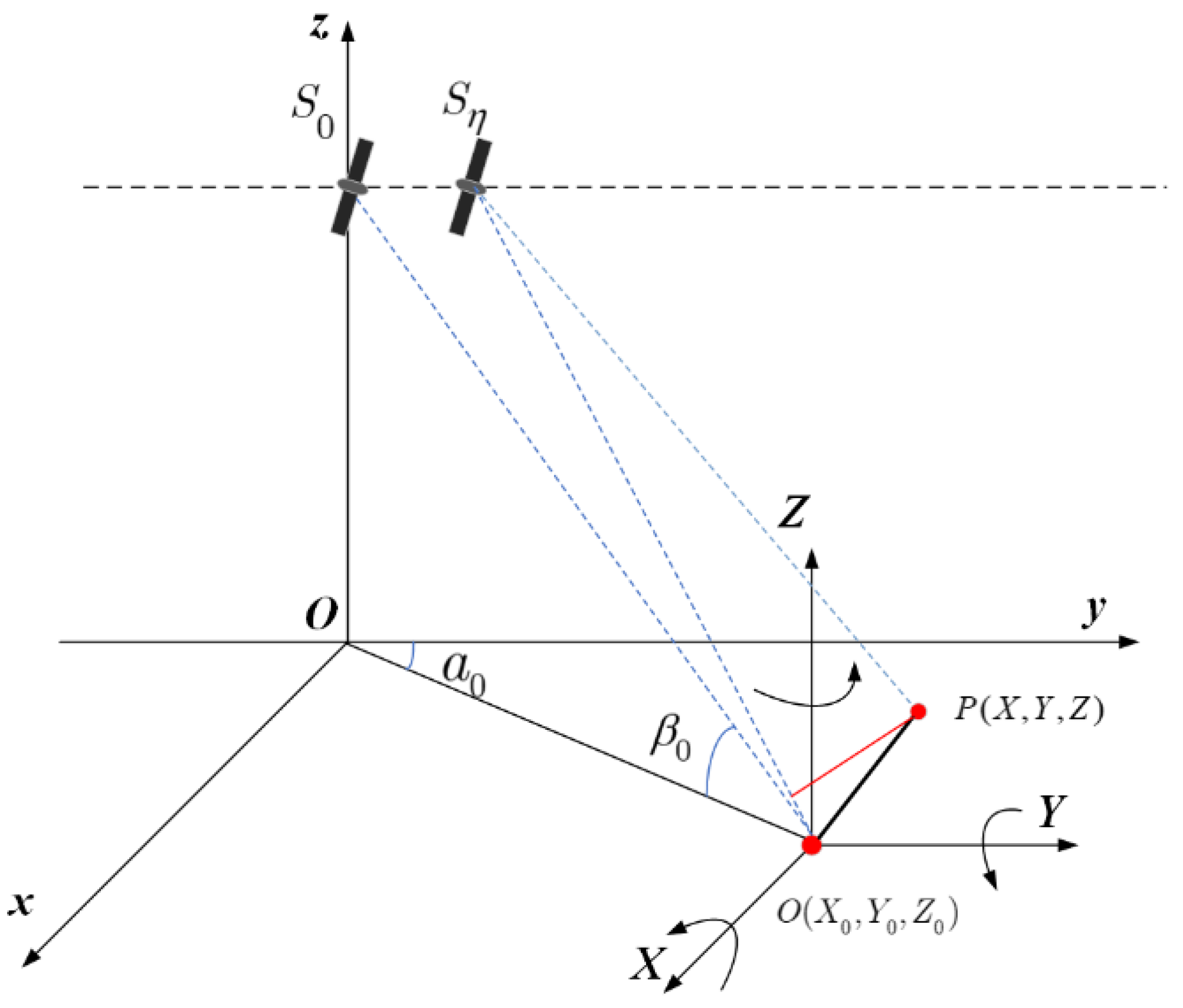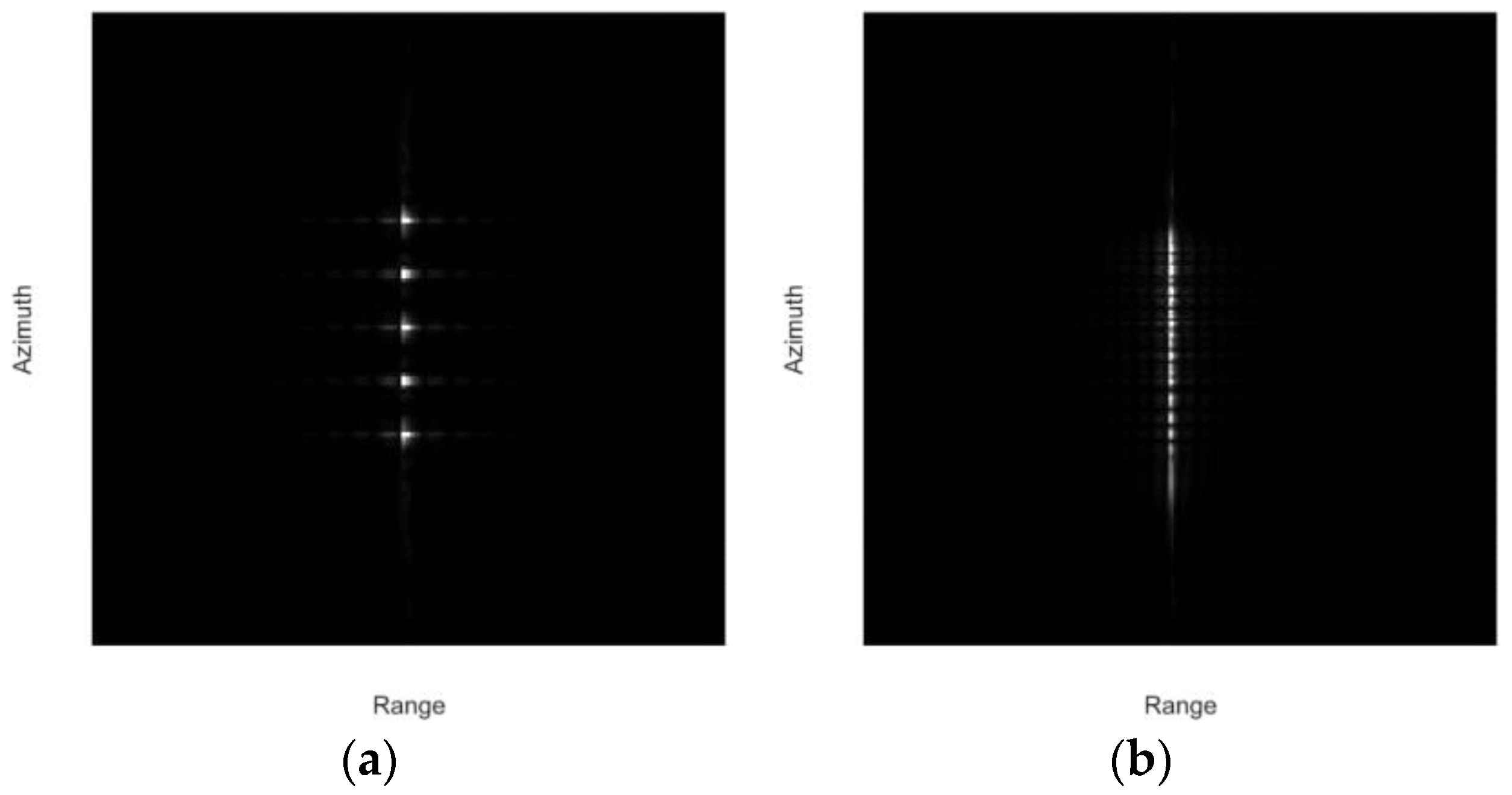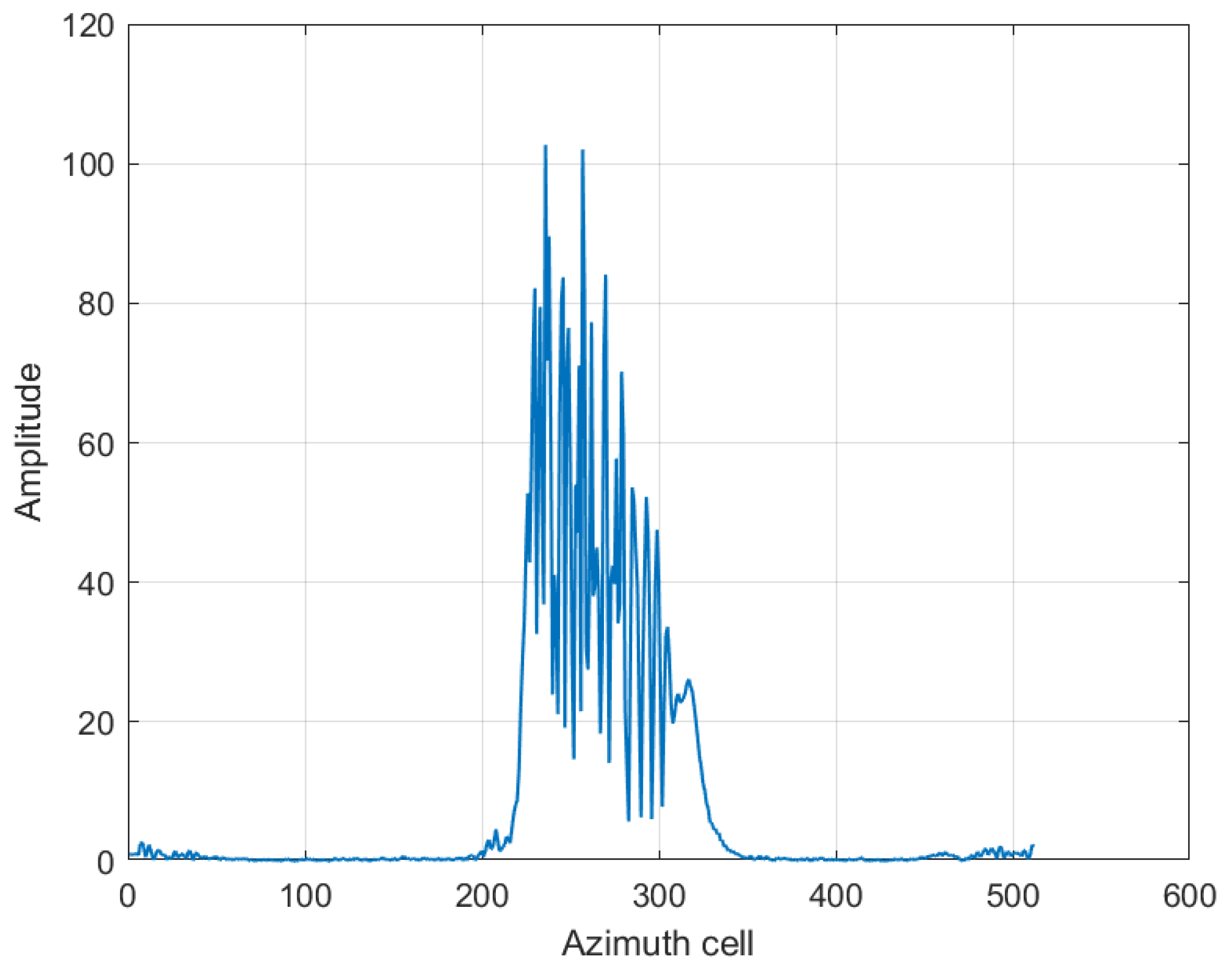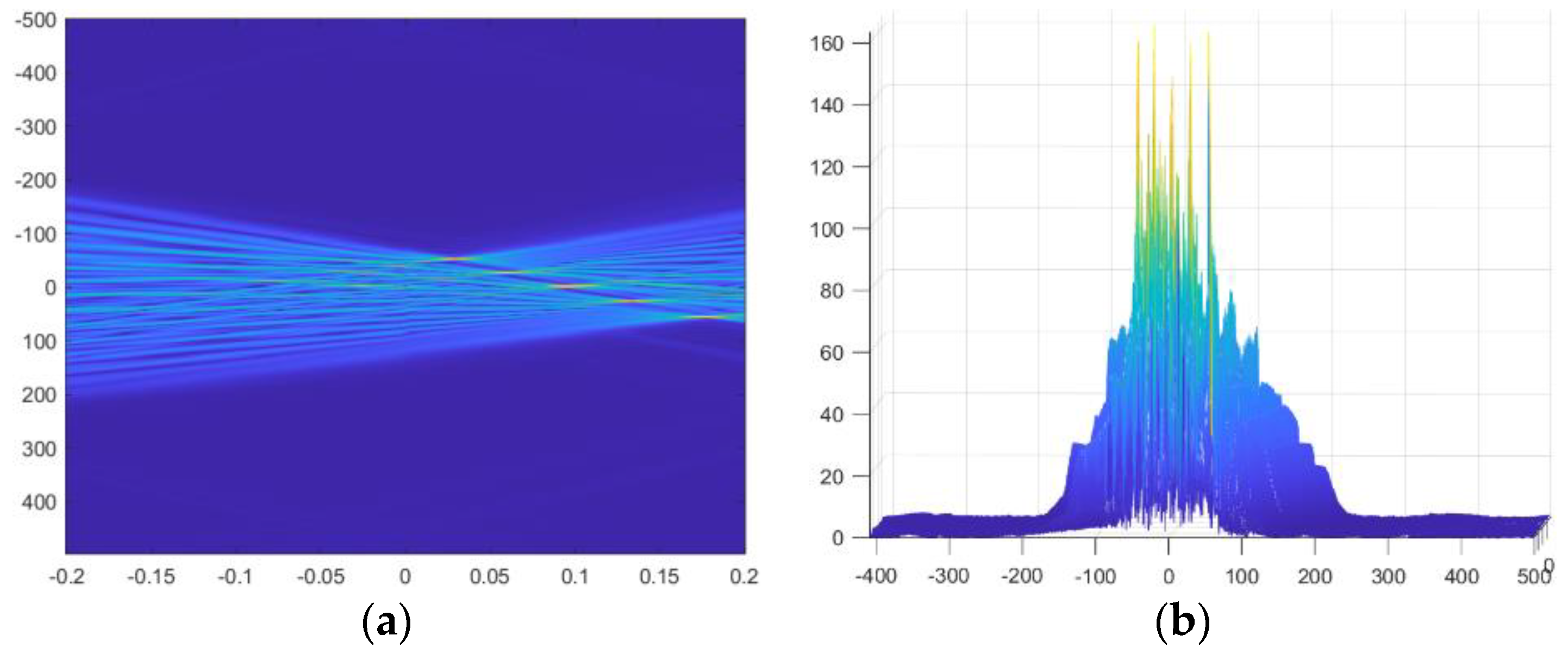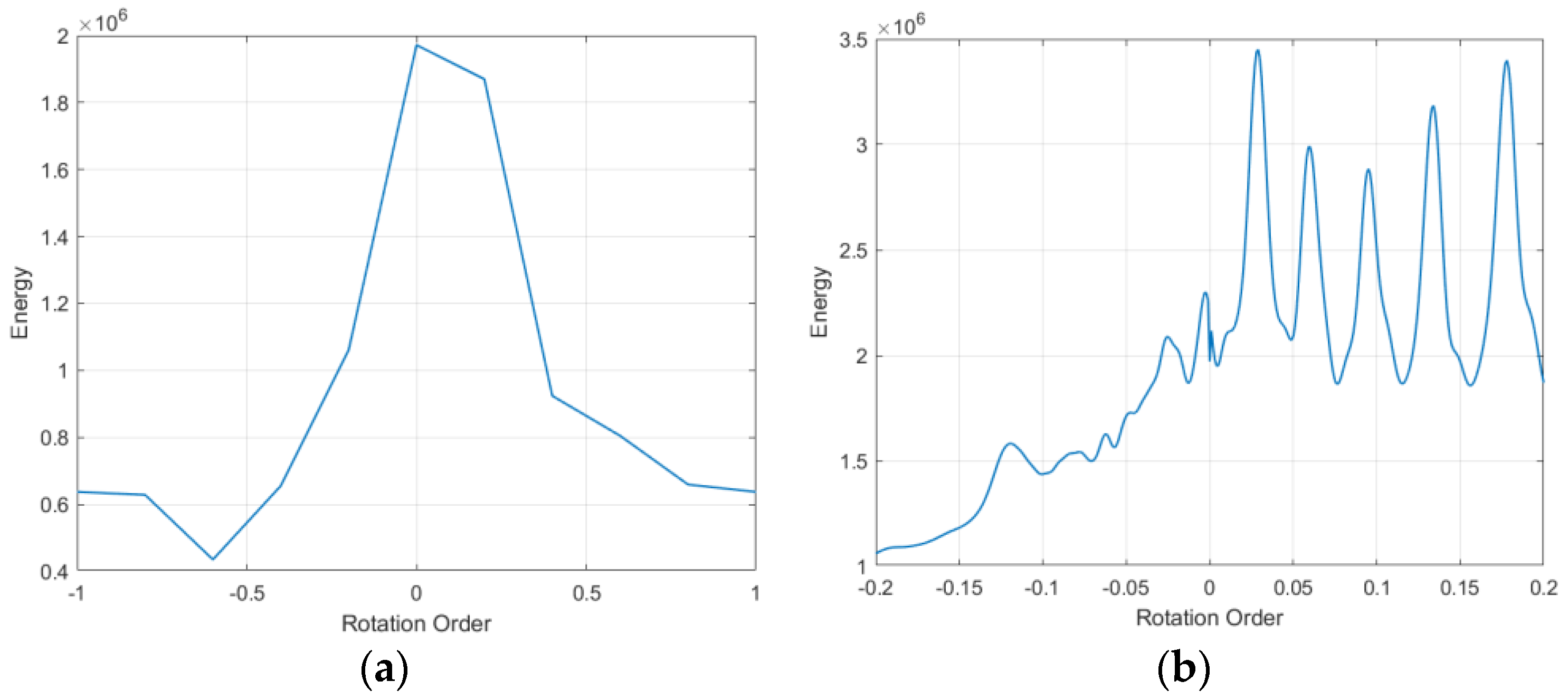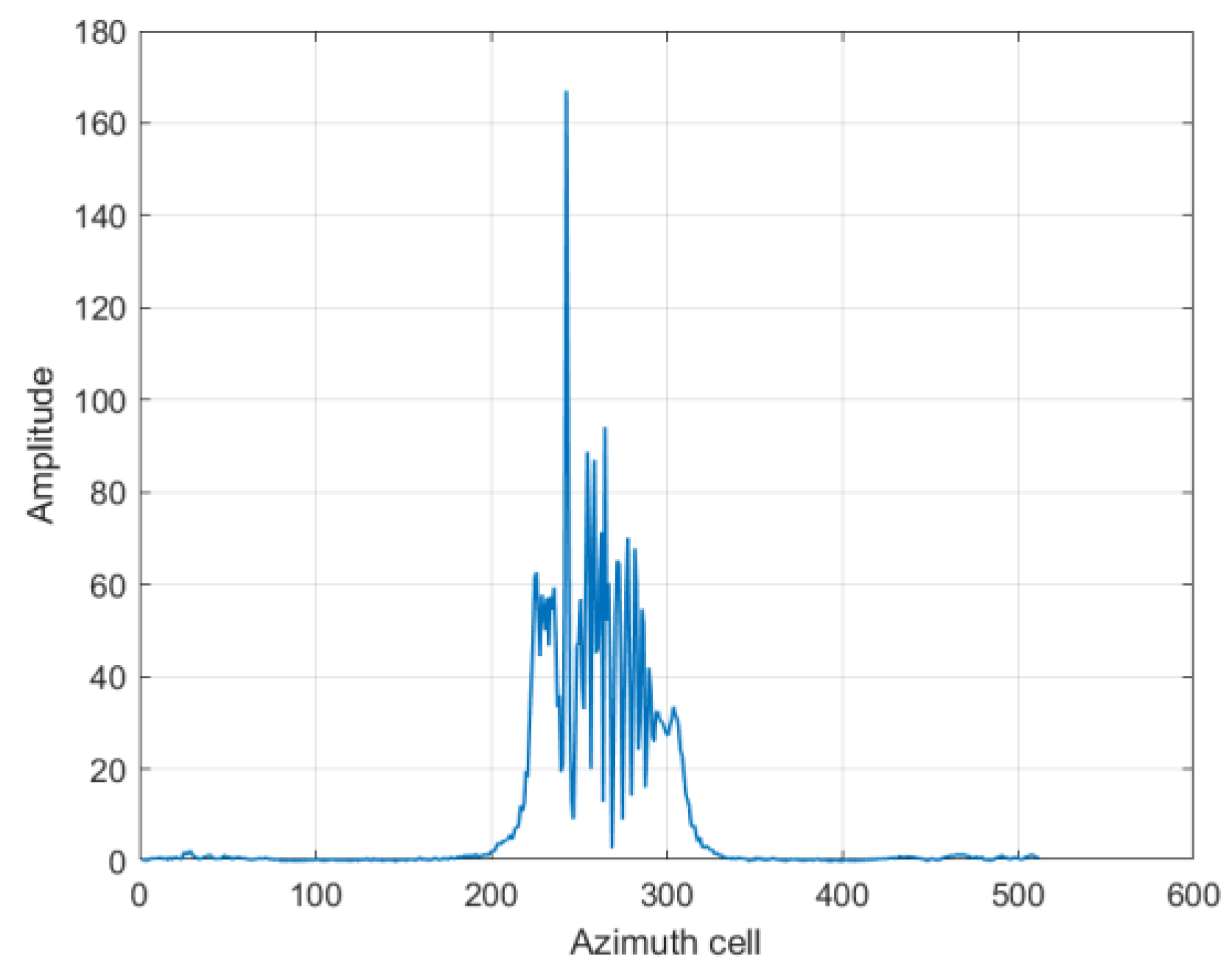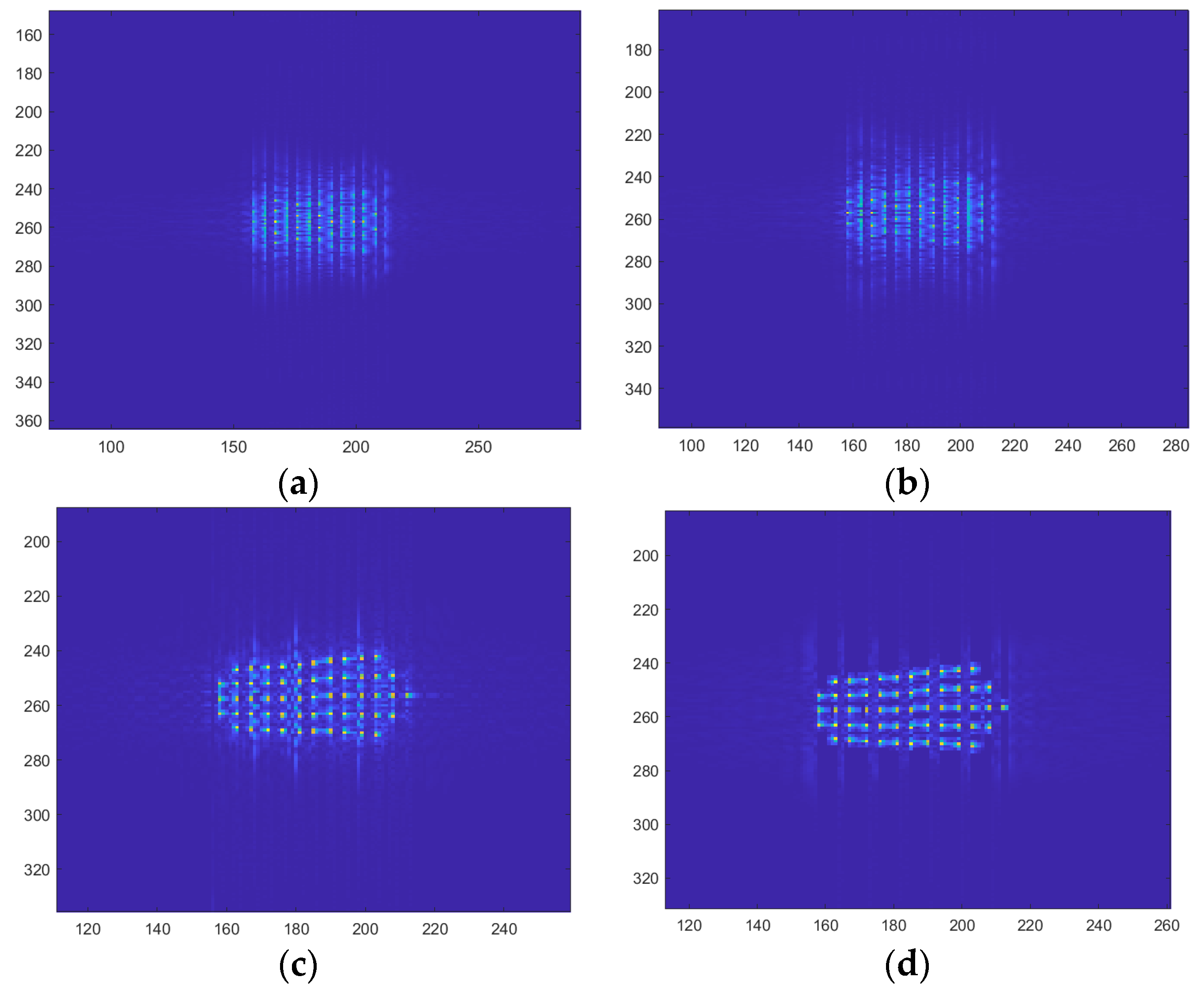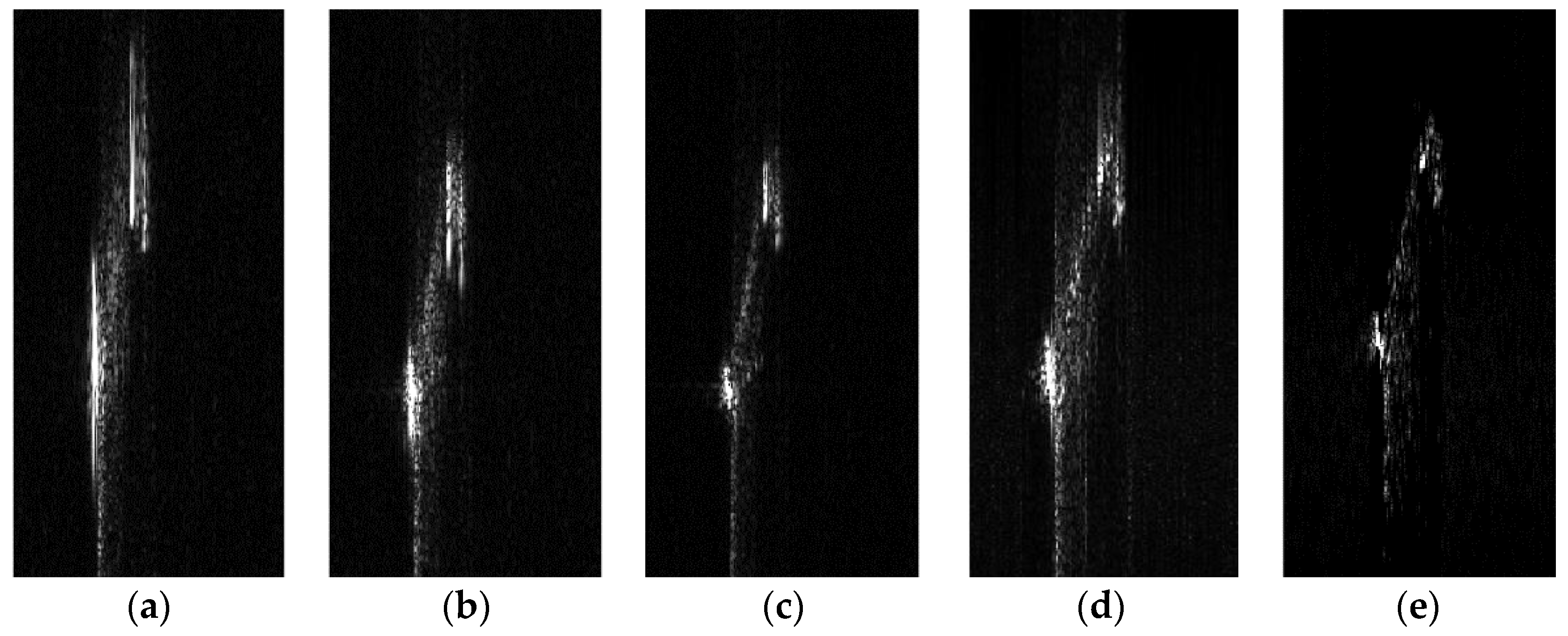1. Introduction
Synthetic aperture radar (SAR) is capable of obtaining high-resolution images of the sea surface, even in adverse weather conditions or at night, which is not possible with passive sensors, such as optical cameras [
1,
2,
3]. Ships are critical targets for maritime surveillance and their detection and identification in SAR images hold significant value for economic and military interests [
4,
5,
6]. Researchers have proposed numerous algorithms for ship detection in SAR images, with satisfactory results [
7,
8,
9,
10,
11,
12,
13,
14,
15,
16,
17,
18,
19]. However, it is very difficult to further recognize ships, because ships in motion at sea exhibit azimuthal defocusing in SAR imagery [
20,
21,
22,
23,
24,
25,
26,
27,
28,
29].
In ideal conditions, SAR emits electromagnetic waves in a uniform linear motion to illuminate a stationary target on the ground. The reflected signal from the target is then collected and compressed in the range and azimuth direction to generate a two-dimensional image. In practice, the trajectory of the SAR platform is non-ideal, due to the effects of turbulence and wind. In order to achieve high resolution imaging, researchers have proposed numerous autofocus algorithms [
30]. However, these autofocus algorithms only compensate for phase errors caused by the non-ideal motion of the SAR platform, and not those caused by the ship’s motion. As a result, the moving ship remains defocused in the SAR image.
In order to improve the recognition performance, we need to refocus SAR for moving ships to accurately obtain the structure of the ship. Since the motion of ships can be equated to the non-ideal motion of the SAR platform, SAR autofocus methods are also applicable to SAR moving ship refocusing. Classical SAR autofocus methods assume that each scattering point has the same phase error. There are two main types of autofocus algorithms. One class of methods for autofocusing is based on phase error function, such as map drift (MD) [
31,
32] and phase gradient autofocus algorithms (PGAs) [
33,
34]. Another class of methods is based on SAR image quality, such as fast minimum entropy phase compensation (FMEPC) algorithms [
35,
36,
37,
38] and maximum contrast algorithms [
39,
40,
41]. In calm sea conditions, ships primarily move in linear motion through their own propulsion, and the phase error of each scattering point on the translational ship is the same. Therefore, the above methods can improve the image quality of SAR-translated ships. However, ships can swing as they are affected by wind and waves in rough seas [
42,
43,
44]. When this occurs, the velocity of each scattering point on the ship is different, resulting in varying phase error for each part of the ship. Therefore, the above traditional methods cannot achieve well-focused performance on the SAR images of swing ships.
There are currently four types of methods with which to refocus 3D swing ships in SAR images. The first class of methods is based on the idea of splitting the image into subimages. Aron Sommer et al. [
45] first split an SAR ship image into subimages and used a maximum contrast algorithm to estimate the phase error of each subimage. A second-order fit was then performed with the Levenberg–Marquardt algorithm in order to obtain the phase error of the entire SAR image, thus refocusing the SAR 3D swing ship image. Based on this, Li et al. [
46] proposed a hybrid coordinate system and improved the calculation of the phase error for the subimages, which ultimately improved the speed of the algorithm. Yu et al. [
47] divided the ship image into subimages with different sizes, according to the difference in the image entropy of a ship’s different parts, and then used the PGA algorithm to compensate for each subimage. However, this type of approach must ensure that each subblock is small enough that the phase error within the subimage can be considered spatial-invariant phase error. Moreover, reducing the size of the subimage can lead to a decrease in the accuracy of the phase error estimation. In contrast, if the subimage is large, the phase error may still contain spatial-variant phase error.
The second class of methods aims to establish a fine spatial-variant phase error model. Brian et al. [
48] constructed a range-variant phase error model that solved phase error through image quality optimization and used it to refocus the SAR images of rotating targets. Huang et al. [
49] considered the azimuth-variant phase error and proposed a two-dimensional spatial-variant phase error compensation method based on maximum image contrast for refocusing ISAR images. However, the phase error model constructed using these methods may not represent the true phase error of swing ships.
The third class of methods uses ISAR techniques to select the time period when the ship’s motion is stable. Based on this idea, Jia et al. [
50] mapped the SAR defocused ship images into the ISAR equivalent echo domain. The phase error caused by the ship translation is first compensated. Thereafter, the optimal imaging time was selected using a maximum image contrast search method. Finally, a high-resolution image was obtained using an iterative adaptive method. Cao et al. [
51] used the range-instantaneous Doppler (RID) algorithm in the equivalent ISAR echo domain to obtain a clear SAR ship image. However, this type of approach reduces the resolution of the SAR image, as it selects only a part of the time.
The final class of methods uses deep learning techniques to learn complex mapping relationships between defocused and focused SAR ship images. Lu et al. [
52] improved the original Unet network based on SAR imaging characteristics. The trained network was able to refocus simulated moving targets, demonstrating the effectiveness of deep learning techniques in SAR moving target refocusing. Liu et al. [
53] proposed an autofocus method based on ensemble learning, constructing a convolutional extreme learning machine (CELM) with which to estimate phase errors. This method achieved a good balance between focusing quality and processing speed. Hua et al. [
54] considered this problem as a regression problem in the field of deep learning. A complex-valued neural network was then constructed and trained using simulated data to refocus SAR 3D swing ship images. However, deep learning techniques require a large dataset, and obtaining real samples can be difficult.
In fact, the main reason for SAR moving ship defocusing is the erroneous matched filtering in the azimuth direction, which results in residual linear frequency-modulated (LFM) signals in this direction of the SAR image. The LFM signal exhibits excellent energy aggregation after Fractional Fourier Transform (FrFT) at its optimal rotation order [
55]. The application of FrFT to SAR moving targets has been extensively studied in recent years [
56,
57,
58,
59,
60,
61,
62,
63]. These methods are all specific to SAR echo data, while Pelich et al. [
64] used this property to perform FrFT on each azimuth line of the single-look complex (SLC) SAR image, which can refocus the SAR translational ship very well. However, each azimuth line of the 3D swing ship is not a single LFM signal, as there are multiple scattering points with different velocities at each range cell. In this paper, the phenomenon that scattering points at different locations on a 3D swing ship exhibit different degrees of defocusing is defined as the spatial-variant defocusing property. Based on the spatial-variant defocusing property, a new SAR 3D swing ship image refocusing algorithm is proposed in this paper. The contribution of this paper mainly includes the following aspects:
By investigating the SAR imaging characteristics of 3D swing ships, this paper constructs a SAR imaging model for such ships and further reveals the spatial-variant defocusing property of 3D swing ships in SAR imaging.
The authors of this paper propose to model each azimuth line of the SAR 3D swing ship image as an MC-LFM signal to address the spatial-variant defocusing problem. This approach simplifies the task of refocusing the 3D swing ship by converting it into the task of refocusing the MC-LFM signal.
In order to refocus each azimuth line, the authors of this paper first use Fractional Autocorrelation (FrAc) to accelerate the precise estimate for the optimal rotation order set of the MC-LFM signal [
65]. The azimuth line is then refocused by performing FrFT on each LFM component at its optimal rotation order. This achieves a good balance between focusing quality and processing speed.
We conduct sufficient experiments using simulated data and Gaofen-3 SAR images. The experimental results show that the proposed algorithm can overcome the spatial-variant defocusing property of 3D swing ships. Compared with state-of-the-art algorithms, our method reduces image entropy by an order of magnitude, which can improve the recognition of SAR ships. These experimental data are published at
https://github.com/RefocusWang/SAR_Swing_Ship (accessed on 1 June 2023). Scholars interested in this issue can further study this data.
The remainder of this paper is organized as follows.
Section 2 establishes the SAR imaging signal model for a 3D swing ship and analyzes its spatial-variant defocusing property.
Section 3 introduces the method that the authors of this paper propose.
Section 4 validates the performance of the proposed method using simulated SAR images and real high-resolution SAR images from Gaofen-3.
2. Geometry and Signal Model
The 3D swing of a ship is the pendulum motion of the ship around its own longitudinal, lateral, and vertical axes [
27], which are referred to as roll, pitch, and yaw, respectively, as shown in
Figure 1. The geometric relationship between the 3D swing ship and the SAR platform is shown in
Figure 2. Firstly, a fixed space coordinate system
is established to describe the absolute motion of the ship. Assume that the coordinate of the ship’s center of gravity
in the fixed-space coordinate system is represented by
. Taking the ship’s center of gravity
as the origin, the bow direction as the axis
, a direction perpendicular to the bow direction and parallel to the plane of the ship’s body as the axis
, and a direction perpendicular to the plane of the ship’s body as the axis
, a ship-fixed coordinate system
, which describes the positions of a ship’s scattering points relative to the ship’s center of gravity
, is established.
Assume that at the initial moment, the ship-fixed coordinate system is parallel to the fixed-space coordinate system. At time
, the roll, pitch, and yaw angles of a certain scattering point
P on the ship-fixed coordinate system are represented by
and
respectively.
where
represent the maximum swing amplitude of roll, pitch, and yaw motions,
represent the angular frequencies of swing motions, and
represent the values at the initial phase. Thereafter, the coordinates of point
P in the fixed-space coordinate system can be expressed through the coordinate rotation matrix
as
The distance from the SAR platform to point
P can be approximately expressed as
From the above equation, it can be seen that an additional phase is created when the ship swings, compared with a stationary target. To simplify the analysis, when the ship is only yawing (i.e.,
), the additional phase error can be expressed as follows:
where
and
.
The above equation shows that the phase error caused by yaw is a sinusoidal function. As the ship swings slowly, over a period of more than ten seconds, the phase error can be approximated as a polynomial of no higher than third order using Taylor expansion within the synthetic aperture time (one second) of the space-borne SAR.
However, compared with the ship’s translational motion, the ship’s 3D swing is not a homogeneous motion, resulting in spatial-variant phase error. In the above equation, represents the distance from the scattering point to the swing axis . This shows that the phase error of each scattering point is related to its distance from the swing axis when the ship yaws. Therefore, the 3D swing of the ship causes the phase error of each scattering point to be closely related to its spatial position, resulting in spatial-variant phase error. The spatial-variant phase error caused by the ship’s 3D swing renders traditional autofocus algorithms ineffective. Consequently, refocusing 3D swing ship images is a very challenging problem.
3. Proposed Method
In this section, the proposed method for refocusing swing ships in SAR imagery based on the spatial-variant defocusing property is described. The flowchart of the proposed method is shown in
Figure 3.
3.1. Selecting a Ship’s Azimuth Lines
SAR usually obtains large-area images of the sea, and in order to refocus SAR moving ships, it is first necessary to obtain a subimage of the ship through ship detection algorithms. However, there are still sea surface backgrounds in the subimage, which need to be further removed in order to obtain the azimuth line set of the ship target. Only the signals in the azimuth line set need to be processed, which can effectively reduce the computational load. Ships are typically made of metal, and their backscattering coefficients are strong, so a ship’s azimuth lines can be selected based on the energy difference between the ship target and the sea surface background.
For a SAR ship image
with a size of
, the energy of the azimuth line at the
n’th range cell
and the mean energy of all azimuth lines
can be defined as
where
represents the number of azimuth cells,
represents the number of range cells, and
is a two-dimensional complex matrix representing a single-look complex (SLC) SAR image.
As the energy of a ship’s azimuth lines on the SAR image is much greater than the energy of the azimuth lines on the sea surface, the azimuth lines with energy greater than the average energy
are selected as the ship’s azimuth line set
.
3.2. Modeling Each Azimuth Line as an MC-LFM Signal
From the analysis in
Section 2, it is clear that the phase error of scattering points at different positions on the 3D swing ship in SAR imaging is not the same. The Equation (5) can be further derived as
Since the swing period of the ship is much longer than the synthetic aperture time of space-borne SAR, the above equation can be approximated using the Taylor expansion as
As shown in Equation (12), the phase error of a scattering point on the 3D swing ship is an LFM signal, where
is the distance between the scattering point and the swing axis. Therefore, the phase error of each scattering point on the 3D swing ship is the LFM signal with different modulation frequencies. After azimuth compression, each scattering point on the ship corresponds to a residual LFM signal in the SAR image due to the erroneous matched filtering. Based on the spatial-variant defocusing property of the SAR 3D swing ship image, each range cell in the SAR image can be modeled as an MC-LFM signal. Thus, the azimuth line
in the ship’s azimuth line set
can be represented as
where
is the
i’th component of
, with a modulation frequency of
and a center frequency of
.
3.3. Calculating the Optimal Rotation Order Set
FrFT decomposes a signal into the space of orthogonal basis functions consisting of LFM functions and is a generalized form of the Fourier Transform. The FrFT of a signal
can be expressed as
where the kernel function
is defined as
where
is an integer,
is the rotation angle, and
is the rotation order of the FrFT.
In FrFT, the modulation frequency
and initial frequency
of the LFM basis function change as the rotation angle
changes from
to
. As a result, the signal is projected on different LFM basis functions as the rotation angle changes, and the magnitude of the projection value reflects the similarity of the signal to the different LFM basis functions. Therefore, by selecting the optimal rotation order in which to perform FrFT on the LFM signal, the LFM signal after FrFT will exhibit energy aggregation and become an impulse signal. In order to obtain the optimal rotation order in practical calculation, it is necessary to perform FrFT on the LFM signal at different rotation orders. The maximum value of the transformed signal energy in the two-dimensional parameter space
corresponds to the optimal rotation order of the LFM signal.
Based on the excellent aggregation capability of FrFT on the LFM signal, Pelich performed FrFT for each azimuth line on the SAR image at its optimal rotation order to obtain a clear SAR image of the moving ship. However, the azimuth line of a 3D swing ship is an MC-LFM signal. At the optimal rotation order, only one LFM component of the azimuth line can be refocused using FrFT, but the rest of the LFM components cannot be refocused. In order to refocus the MC-LFM signal, the optimal rotation order of each LFM component must be obtained. The optimal rotational order for each component of the MC-LFM signal is combined as its optimal rotation order set in this paper. Fractional autocorrelation (FrAc) can effectively distinguish LFM signals with different modulation frequencies. Therefore, the authors of this paper use FrAc to calculate the optimal rotation order set of the MC-LFM signal.
The FrAc of the signal
can be expressed as
where
represents the complex conjugate,
represents the delay factor, and
represents the rotation angle. The FrAc of the signal can be calculated using FrFT and inverse Fourier Transform.
where
represents the inverse Fourier Transform and
represents the signal
after FrFT at the rotation angle
.
The FrAc for one azimuth line
of the SAR 3D swing ship image
can be expressed as
For
, the auto-term of
can be expressed as
For
, the cross-term of
can be expressed as
From the expressions of the auto-term and cross-term, it can be seen that the energy of the auto-term is concentrated on the straight lines passing through the origin, where the slopes of these lines represent the different modulation frequencies of the LFM component
. On the other hand, most of the cross-term energy is concentrated on straight lines that do not pass through the origin, and cross-term energy with different modulation frequencies can be ignored, compared with the auto-term. The energy of the signal after FrAc is defined as
When the rotation order matches the modulation frequency of one LFM component, the energy of the signal after FrAc has a peak, and the optimal rotation order corresponding to this component in FrFT is . Therefore, the energy distribution of the signal after FrAc at different rotation angles can be used to calculate the parameters of each component for the MC-LFM signal.
The scattering points on the 3D swing ship have different velocities, but the velocities are relatively close in magnitude, which places the optimal rotation order of each LFM component within a certain range. Therefore, the optimal rotation order set is calculated using a two-step method and Algorithm 1 illustrates the specific implementation. First, the energy
of the MC-LFM signal after FrAc with a greater step size
in the interval
is calculated, and the rotation order
in which the position of the maximum value of
is obtained. Since there are multiple optimal rotational orders of the MC-LFM signal near the rotation order
, the energy
of the MC-LFM signal after FrAc is further calculated using a smaller step
in the subinterval
. As a result, the peaks of the energy
correspond to the precise optimal rotation order of each LFM component. Finally, the corresponding rotation orders are sorted according to the magnitude of the peak to obtain the optimal rotation order set
of the MC-LFM signal.
| Algorithm 1 The algorithm of calculating the optimal rotation order set |
| Input: A ship’s azimuth line |
| Output: The optimal rotation order set |
| |
| for in |
|
|
|
end for |
|
|
|
|
| for in |
|
|
|
end for |
|
|
|
|
3.4. Refocusing Each Azimuth Line
The components of the MC-LFM signal are difficult to distinguish in the time domain, but after performing FrFT at each component’s optimal rotation order, each component will become an impulse signal. Therefore, after obtaining the optimal rotation order set for the azimuth line, the azimuth line can be refocused using FrFT and Algorithm 2 illustrates the specific implementation.
First, FrFT is performed at the optimal rotation order
on the azimuth line
, and the LFM component corresponding to this optimal rotation order
will be refocused. All peaks of the signal
are detected, and if the peak magnitude of the signal
is close to its maximum value, the peak is the refocused signal of the corresponding LFM component. In the fractional-order domain, each refocused signal is filtered out with a narrowband filter and accumulated to obtain the refocused signal
of the corresponding LFM component at optimal rotational order
. The residual signal
is further transformed to the time domain using inverse FrFT.
Thereafter, FrFT is performed on the residual signal
at the second optimal rotation order
. If the maximum value of the refocused signal after the second transformation is much less than that of the first transformation, the loop is terminated. Otherwise, the refocused signal
is continually filtered. By repeating this operation, each refocused signal obtained is accumulated to obtain the entire refocused signal
from the MC-LFM signal.
If the energy of the refocused signal
is less than a certain proportion of the energy of the original signal
, this indicates that there are still LFM components outside of the current subinterval. In this case, the subinterval is further expanded, the optimal rotation order set is recalculated, and the refocusing process is repeated as described above until the energy of the refocused signal meets the predetermined threshold. Finally, by replacing the corresponding original azimuth lines in the SAR image with the refocused azimuth lines, a clear SAR image of the 3D swing ship can be obtained.
| Algorithm 2 The specific implementation of refocusing one azimuth line |
| Input: Optimal rotation order set and azimuth line |
| Output: Refocused azimuth line |
| for |
|
|
|
|
|
|
|
if
|
|
break |
|
else |
|
|
|
|
|
end if |
|
end for |
|
|
3.5. Numerical Analysis of Computional Burden
Suppose the size of a SAR 3D swing ship image is
, where
is the number of range cells and
is the number of azimuth cells. The time complexity, for both the inverse FFT and the Discrete FrFT, for a signal of length
is
. Therefore, the time complexity required to calculate the energy of an azimuth line after FrAc at each rotation order is
. If the coarse step is
and the fine step is
, then the time complexity required to compute the optimal rotation order set for the azimuth line of the
i’th range cell is
.
If the azimuth line consists of
LFM signals with different tuning frequencies, the time complexity required to refocus the azimuth line is
.
Thus, the time complexity
required to refocus the entire SAR image can be expressed as
If the optimal rotation order set of the azimuth line is calculated using the method in [
56], the required time complexity
can be expressed as
For a 3D swing ship, there are multiple scattering points at each range cell, and is much greater than 2. Therefore, the proposed algorithm can reduce the time complexity.

